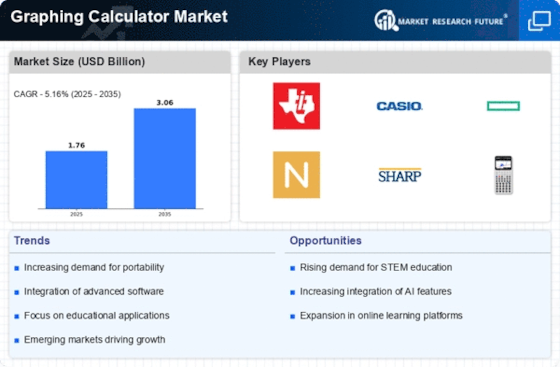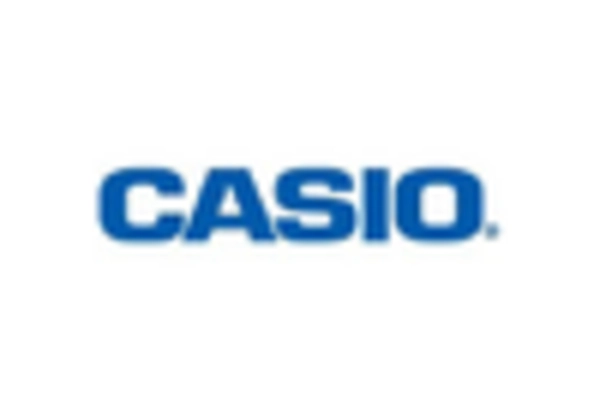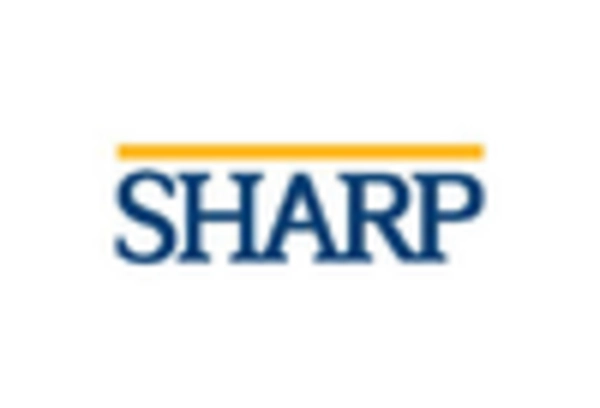The Graphing Calculator Market is currently characterized by a dynamic competitive landscape, driven by technological advancements and an increasing demand for educational tools that facilitate complex mathematical computations. Key players such as Texas Instruments (US), Casio (JP), and NumWorks (FR) are at the forefront, each adopting distinct strategies to enhance their market positioning. Texas Instruments (US) continues to focus on innovation, particularly in integrating advanced software capabilities into their calculators, thereby appealing to both educational institutions and individual users. Meanwhile, Casio (JP) emphasizes regional expansion, particularly in Asia, where they are enhancing their distribution networks to capture a larger share of the growing student population. NumWorks (FR), on the other hand, is leveraging partnerships with educational platforms to promote their user-friendly graphing calculators, which are designed to simplify learning and engagement in mathematics.
In terms of business tactics, companies are increasingly localizing manufacturing to reduce costs and improve supply chain efficiency. This trend is particularly evident in the operations of Hewlett-Packard (US), which has optimized its supply chain by establishing production facilities closer to key markets. The competitive structure of the market appears moderately fragmented, with several players vying for market share, yet the influence of major companies remains substantial, shaping pricing strategies and product offerings across the board.
In August 2025, Texas Instruments (US) announced a collaboration with leading educational institutions to develop a new line of graphing calculators that incorporate artificial intelligence features. This strategic move is likely to enhance the learning experience by providing personalized feedback to students, thereby positioning Texas Instruments as a leader in educational technology. The integration of AI into their products may not only attract new customers but also reinforce their existing user base, as educators increasingly seek tools that can adapt to diverse learning styles.
In September 2025, Casio (JP) launched a new series of graphing calculators specifically designed for the Asian market, featuring localized content and language support. This initiative underscores Casio's commitment to catering to regional needs and preferences, potentially increasing their market penetration in a highly competitive environment. By aligning their product offerings with local educational standards, Casio may enhance its appeal among students and educators alike, thereby solidifying its market position.
In October 2025, NumWorks (FR) unveiled a partnership with a prominent online learning platform to provide integrated solutions that combine their graphing calculators with digital learning resources. This collaboration is indicative of a broader trend towards digitalization in education, where traditional tools are increasingly being integrated with online platforms. Such strategic alliances may not only enhance the functionality of NumWorks' products but also expand their reach within the educational sector, positioning them favorably against competitors.
As of October 2025, the Graphing Calculator Market is witnessing significant trends towards digitalization, sustainability, and the integration of artificial intelligence. These trends are reshaping competitive dynamics, as companies increasingly seek to differentiate themselves through innovative product offerings rather than solely competing on price. Strategic alliances are becoming more prevalent, enabling companies to leverage complementary strengths and enhance their market presence. Looking ahead, it appears that competitive differentiation will increasingly hinge on technological advancements, user experience, and the reliability of supply chains, marking a shift towards a more innovation-driven market landscape.
















Leave a Comment